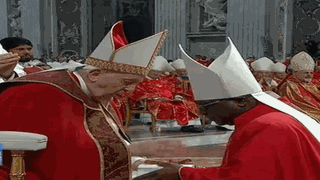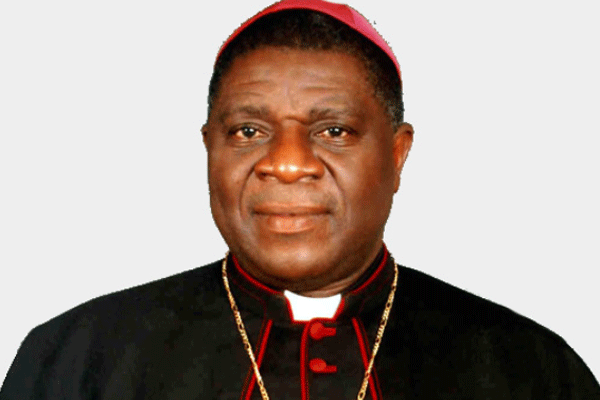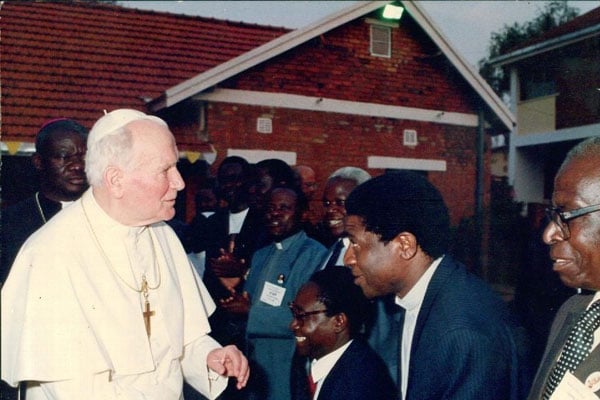
The Archbishop of Kampala Paul Ssemogerere (right) receives his pallium from Pope Francis at St Peter’s Basilica in the Vatican, Rome, on June 29. Photos/The Vatican media
|National
Prime
What Archbishop Ssemogerere’s new pallium signifies
What you need to know:
- Honour: The pallium that is bestowed on top clergy symbolises papal authority within a given ecclesiastical province.
The Archbishop of Kampala Paul Ssemogerere on June 29 received his pallium from Pope Francis at St Peter’s Basilica in the Vatican, Rome, during holy mass celebrations in honour of the martyrdom of Saints Peter and Paul Apostles.
The pallium is a liturgical vestment, worn by the pope, archbishops and some bishops in the Roman Catholic Church. It is bestowed by the pope as a symbol of participation in their papal authority.
Explaining the significance of the honour, Fr Dr Pius Male, the Chancellor of Kampala Archdiocese, who is among the 50-man Ugandan delegation that travelled to Rome last week, told the Monitor in a Whatsapp message that Kampala Archdiocese has officially got a new shepherd.
“It has been a wonderful holy journey and a symbol of unity. The pallium bestowed on our archbishop means that a shepherd is among its sheep within a given ecclesiastical province in our case, the Kampala Province with suffragan diocese, Kiyinda Mityana, Lugazi, Masaka, Kasana Luweero, and Kampala the metropolitan. We are happy to get a new shepherd,’’ he said.
The bishop is among the 44 archbishops from 32 countries who received the vestment from the archbishop.
The tradition of the pallium dates back to at least the fifth century. It is given to the newly-named archbishops throughout the world.
The Leader of Opposition in Parliament, Mr Mathias Mpuuga, the other delegate, said the church and its followers are now moving in the right direction with a shepherd in place.
“The core teachings of the Church are epitomised in our appreciation of guidance from the shepherd! Our duty is to pray for him [Bishop Ssemogerere] to be inspired by the spirit to not only lead the flock in truth and love; but also to have the courage to crack the whip on the flock; out their deliberate erratic ways; to be able to speak the truth to power, aware of his special anointment as the voice of the voiceless and protector of the weak in the face of injustice and especially state criminality,” he said.

Archbishop Ssemogerere (with cross), his delegation and other Christians outside St Peter’s Basilica in the Vatican, Rome. PHOTO/Vatican media
Pope Francis celebrated St Peter and Paul Day with a message that true freedom is found in Christ and that the two were great apostles of the gospel and two pillars of church.
The feast is celebrated every June 29 in honour of their martyrdom in Rome.
The two were martyred for their faith in Rome where their remains are kept. They are remembered for carrying the good news of Jesus Chris to the world.
And to the flock, Father Joseph Mukiibi, the head of social communications at the Archdiocese of Kampala, explains that the pallium is a sign of allegiance to the leadership of the pope and his bishops and archbishops.
“The pallium means the Archbishop has officially been entrusted with the power in pastoral care of the church. It is, therefore, a call for Christians to pay allegiance to the leadership of the pope and his bishops,” he said.
Father Jean Marie Nsambu, an administrator of the Holy Saviour Catholic Church in Lockport, Louisiana, and a former journalist remarks that the pallium typifies archbishops’ participation in the supreme pastoral power of the pope.
“More concretely, since it (pallium) is made out of wool from lambs.
SEE PICTURES: Kampala's 4th Archbishop Paul Ssemogerere installed
The pallium is a symbol of the Good Shepherd Christ, whom the pope represents, who goes out to seek the sick and lost sheep/lamb, finds it and leads it to verdant pasture. Pallia are basically insignia symbolising territorial authority, and are worn over the vestments for celebration of Mass.
‘‘As leader of the Church universally, the pope may don his pallium in any diocese in the world,” he explains.
“However, an archbishop may not wear his pallium outside the metropolitan province for which he is archbishop.
For instance, Archbishop Paul Ssemogerere can only put on his pallium while celebrating Mass in any of the dioceses within the metropolitan province of the Archdiocese of Kampala, which includes: Kasana-Luweero, Lugazi, Kiyinda-Mityana, Masaka, and Kampala Archdiocese,” he stressed.
About the pallium
A pallium is a circular scapular-like band worn about the neck, over one’s shoulder, with its pendants dropping, one over the chest, and the other over the back.
They are made of wool from two lambs presented annually as a tax by the Lateran Canons Regular to the Chapter of St John on the feast of St Agnes. The pallium is reserved to the pope and metropolitan Archbishops as individuals. It is not passed on to another pope or archbishop. The pope or archbishop is buried with his pallium when he dies.




